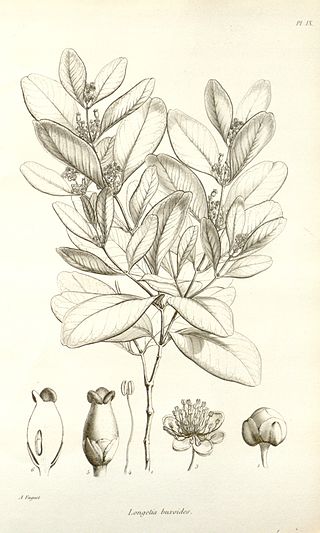
Sebastiania is a genus of flowering plants in the family Euphorbiaceae first described in 1821. It is native to North and South America from Arizona and the West Indies south to Uruguay.
Bernardia is a plant genus of the family Euphorbiaceae first described for modern science as a genus in 1754. It is native to North and South America, as well as the West Indies.
Cheilosa is a monotypic plant genus of the family Euphorbiaceae first described as a genus in 1826. Only one species is recognized: Cheilosa montana, native to Southeast Asia.

Epiprinus is a genus of plant of the family Euphorbiaceae first described as a genus in 1854. It is native to Indochina, Sumatra, southern China, and the Indian Subcontinent.
- Epiprinus balansae(Pax & K.Hoffm.) Gagnep. - Vietnam
- Epiprinus lanceifoliusCroizat - Vietnam
- Epiprinus malayanusGriff. - Myanmar, Thailand, Peninsular Malaysia, Sumatra
- Epiprinus mallotiformis(Müll.Arg.) Croizat - southern India
- Epiprinus poilaneiGagnep. - Vietnam
- Epiprinus siletianus(Baill.) Croizat - Hainan, Yunnan, Assam, Laos, Myanmar, Thailand, Vietnam
Podadenia is a genus of plant of the family Euphorbiaceae first described as a genus in 1821. At present, only species is recognized in the genus, Podadenia sapida, endemic to Sri Lanka.
Neoroepera is a genus of plants in the Picrodendraceae first described as a genus in 1866. The entire genus is endemic to the State of Queensland in northeastern Australia.
- Neoroepera banksiiBenth. - Shire of Cook
- Neoroepera buxifoliaMüll.Arg. - Gladstone District

Petalostigma is a genus of plants under the family Picrodendraceae and the monogeneric subtribe Petalostigmatinae, first defined by von Mueller in 1857. It is native to New Guinea and Australia. They are evergreen, dioecious shrubs or trees.

Neoguillauminia is a genus of plants in the family Euphorbiaceae first described as a genus in 1938. It contains only one known species, Neoguillauminia cleopatra, endemic to New Caledonia. Its closest relative is Calycopeplus from Australia.

Longetia is a genus of plants under the family Picrodendraceae first described as a genus in 1866. It has only one known species, Longetia buxoides, endemic to New Caledonia.

Hyaenanche globosa is a species of plant under the family Picrodendraceae. It is the sole member of the genus Hyaenanche and the subtribe Hyaenanchinae. It is endemic to Cape Province in South Africa.
Scagea is a genus of plants under the family Picrodendraceae described as a genus in 1986.
Aristogeitonia is a plant genus in the family Picrodendraceae, described as a genus in 1908. It is native to Africa and Madagascar.
- Aristogeitonia gabonica - Gabon
- Aristogeitonia limoniifolia - Angola
- Aristogeitonia lophirifolia - Madagascar
- Aristogeitonia magnistipula - Tanzania
- Aristogeitonia monophylla - Tanzania, Kenya
- Aristogeitonia perrieri - Madagascar
- Aristogeitonia uapacifolia - Toliara Province
Stachyandra is a plant genus in the family Picrodendraceae first described as a genus in 1990.

Piranhea is a plant genus under the family Picrodendraceae described as a genus in 1866.

Securinega is a genus of plants in the family Phyllanthaceae, first described as a genus in 1789. As presently conceived, the genus is native to Madagascar and the Mascarene Islands in the Indian Ocean. In the past, it was considered to be much more widespread, thus explaining the long list of species formerly included. It is dioecious, with male and female flowers on separate plants.
- Securinega antsingyensisLeandri - W Madagascar
- Securinega capuroniiLeandri - W Madagascar
- Securinega durissimaJ.F.Gmel. - Madagascar, Mauritius, Réunion, Rodrigues Island
- Securinega perrieriLeandri - W Madagascar
- Securinega seyrigiiLeandri - W Madagascar

Stephanomeria is a genus of North American plants also known as wirelettuce, belonging to the tribe Cichorieae within the family Asteraceae.

Chaenactis is a genus of plants in the family Asteraceae which are known generally as pincushions and dustymaidens.

Deinandra is a genus of flowering plants in the tribe Madieae within the family Asteraceae. Such a genus is not recognized as distinct by all authorities; its species are often treated as members of the genus Hemizonia.

Tetracoccus hallii is a species of flowering shrub in the family Picrodendraceae, known by the common names Hall's shrubby-spurge and Hall's tetracoccus.
Tetracoccus ilicifolius is a rare species of flowering shrub in the family Picrodendraceae known by the common names hollybush and holly-leaved tetracoccus.












